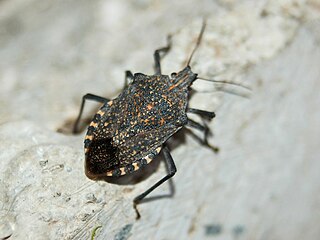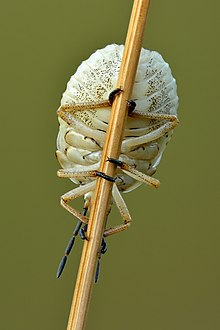
Pentatomidae is a family of insects belonging to the order Hemiptera, generally called shield bugs or stink bugs. Pentatomidae is the largest family in the superfamily Pentatomoidea, and contains around 900 genera and over 4700 species. As hemipterans, the pentatomids have piercing sucking mouthparts, and most are phytophagous, including several species which are severe pests on agricultural crops. However, some species, particularly in the subfamily Asopinae, are predatory and may be considered beneficial.

Elasmostethus interstinctus, the birch shield bug, is species of shield bug in the Acanthosomatidae family. Shield bugs are often called "stink bugs" because they excrete a foul smelling liquid that is used to deter predators.

Dolycoris baccarum, the sloe bug or hairy shieldbug, is a species of shield bug in the family Pentatomidae.

Codophila varia is a species of shield bug belonging to the subfamily Pentatominae in the family Pentatomidae.

Carpocoris mediterraneus, the red shield bug, is a species of shield bug in the family Pentatomidae.

Gymnosoma clavatum is a species of tachinid flies in the genus Gymnosoma of the family Tachinidae.

Tropidothorax leucopterus is a species of ground bugs belonging to the family Lygaeidae, subfamily Lygaeinae.

Apodiphus amygdali is a species of shield bug belonging to the family Pentatomidae, subfamily Pentatominae.

Stagonomus venustissimus, common name woundwort shieldbug, is a species of shieldbug belonging to the family Pentatomidae, subfamily Pentatominae.

Carpocoris pudicus is a species of shield bug in the family Pentatomidae.

Carpocoris is a genus of mostly Palearctic shield bugs in the family Pentatomidae and typical of the tribe Carpocorini. The species of this genus are quite similar.

Campyloneura virgula is a species of bugs in Miridae family. It is the only species in the genus CampyloneuraFieber, 1861.

Eurygaster maura, also known as tortoise bug, is a species of true bugs or shield-backed bugs belonging to the family Scutelleridae.

Dinidoridae is a small family of hemipteran "true bugs" comprising about sixteen genera and a hundred species the Hemiptera suborder Heteroptera. As a group the family does not have any common name. Until the late 19th century they were generally regarded as a subfamily of Pentatomidae.

Micrelytra fossularum is a species of European bugs belonging to the family Alydidae and type genus of the tribe Micrelytrini. It is the only representative of the monotypic genus Micrelytra.

Carpocoris fuscispinus is a species of shield bug in the family Pentatomidae.

Cosmopepla lintneriana, the twice-stabbed stink bug, is a species of insect in the family Pentatomidae. Cosmopepla lintneriana was first described in 1798 by Johan Christian Fabricius as Cimex carnifex, and then again in 1865 by Thomas Say as Cosmopepla bimaculata. Cosmopepla lintneriana is hosted by a variety of plants, including milk thistle, echinacea, asparagus, oats, mint and goldenrod, and is widespread throughout North America, from Canada to Mexico. Adult C. lintneriana are black with a red, orange, or yellow band across the pronotum and a short red stripe along the midline, and two red spots at the apex of the scutellum. Nymph coloration ranges from red to white with black markings that change as they grow.

Peribalus strictus, common name Vernal Shieldbug, is a species of shield bugs in the family Pentatomidae.

Euthyrhynchus floridanus, the Florida predatory stink bug, is a species of carnivorous shield bug in the family Pentatomidae, the only species in the genus Euthyrhynchus. It is native to the hottest parts of the southeastern United States and is considered beneficial because it feeds on many species of pest insects. They also feed on things such as grasshoppers and other small insects. This species also hunts in a pack, with up to twelve.

Proxys punctulatus, the black stink bug, is a species of stink bug in the family Pentatomidae. It is found in the Caribbean Sea, Central America, and North America.






















